Inside the Eagle's Claw
By Victor Smith
(Also see "Making
the Eagle's Claw")
 In
the martial arts today there is so much diversity that students rarely
get a chance to peer past the veil of an art to really understand how
it is composed. Instead, preconceived notions, suppositions or movies
fill in the gaps to create something else. I would like to give everyone
a glimpse into a traditional Northern Chinese system of study, that of
Fann Tzi Ying Jow Pai -- Northern Eagle Claw. In
the martial arts today there is so much diversity that students rarely
get a chance to peer past the veil of an art to really understand how
it is composed. Instead, preconceived notions, suppositions or movies
fill in the gaps to create something else. I would like to give everyone
a glimpse into a traditional Northern Chinese system of study, that of
Fann Tzi Ying Jow Pai -- Northern Eagle Claw.
If you have ever felt the grasp of an Eagle Claw master, the pain is
intense. No ordinary grip, the fingers close like white hot talons of
steel piercing into you. It can be agonizing.
Eagle Claw's roots stretch back over 850 years to the legendary Shaolin
Monastery nestled in mountains of Northern China. And like many other
systems, it too was inspired by the fighting movements of animals (White
Crane, Tiger,Snake, etc.). Eagle Claw's specialty is developing the hand
grip and finger pressure to grasp, trap, seize and manipulate opponents'
limbs, joints, pressure points, veins and other targets. In this way it
resembles Japanese jujutsu with its joint locks and fast take downs. 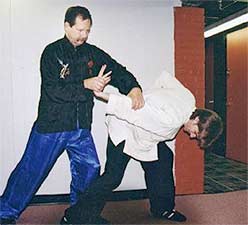 Testimony
to its effectiveness is also seen in the fact that many other Chinese
arts have adopted Eagle Claw techniques. Testimony
to its effectiveness is also seen in the fact that many other Chinese
arts have adopted Eagle Claw techniques.
Historically Eagle Claw was the result of China's Oldest Chin-Na tradition
(the art of seizing, locking, breaking and pressure points) being mixed
with Northern Shaolin Arts. Created during the Sung Dynasty by General
Yui Feh (Ngok Fei in Cantonese, also credited with creating Xing-i), he
is said to have formed the art after seeing how an Eagle effectively used
its claws against its enemies. The art was then taught by the general
to his soldiers.
Passed down over the generations, the art was later modified to include
a Chinese form of gymnastics called Fan-Stu (Faan Tzi), adopted as a method
of countering and maneuvering along with Shaolin long range fighting skills
and the use of weapons. The branch of the system I studied eventually
passed down to Hong Kong and to Master Sheum Leung who later moved and
taught in New York City. Master Sheum in turn passed the system down to
a few 'Master Instructors'. (1)
Today the art represents a vast cultural heritage and repertoire of martial
arts techniques and methods. Included is a progressive mix of striking
and kicking, grabs, locks, throws, and counters to the grabs, locks and
throws, and the open use of pressure points for all of the above. Lightening
fast circular movements are used rather than the direct totally committed
punches of karate. It also employs subtle deflections and body moves to
attack and avoid strikes.
The Structure of Eagle Claw
The system itself consists of acrobatics, the 10 beginning sets used
by the Ching Mo Association, in excess of 50 eagle claw empty hand sets,
a very large number of weapons sets, two person empty hand and weapons
sets, climaxing with the 108 locking form with over 860 individual movements
to be remembered. Then there are the Eagle Claw sparring practices, using
only techniques from the Eagle Claw system and requiring all fights to
go to a completed lock.
The forms are lengthy in the Northern Shaolin tradition. The complete
Eagle Claw curriculum is comprised of more than 75 sets.
The beginning sets used by the Ching Mo Association are not simple. They
are complex systems of study. One of the most basic sets, Tam Tui, can
be a complete system of kung fu in its own right. This makes even the
beginning training in Ying Jow Pai quite challenging.
The study of those Eagle Claw sets builds on the strikes, kicks and eagle
claw grabbing techniques. Decades of work on those claws are one of the
major tools to develop the hand's ability to grasp specific pressure points.
This is supplemented with additional hand and finger strength drills as
well as hands on practice.
The empty hand forms build in complexity until such sets as Hon Kuen
(Walking Form) which incorporates all of the Eagle claw hand and foot
techniques, Lin Kuen (the 50 rows) which contains every variation of eagle
claw locks and may well be more complex than the entire body of Okinawan
Karate itself, and the form Eagle Tames Tiger.
Accompanying these forms are the Eagle Claw formal 2 person practices.
They begin with The Eagle Claw Principles designed to teach the underlying
principle of Eagle Claw technique. They also teach students how to fit
or use their techniques against various attackers and attacks.
Students study many two person sets in order to develop more skill applying
Eagle Claw's locks as well as to learn the counters to those locks. Here
is where the use of acrobatics enters. Acrobatic skills are used to gain
freedom from some of the locks, and well as to retain the lock on the
adversary.
The major two person set is the 108 Locking Form. It teaches108 different
locking techniques. The set is structured to handle 3 to 5 attacks with
counters setting up the individual locking technique. The set is structured
to instruct the practitioner how to enter an attack and move the opponent
so he can be locked. Different sections of the form focus on locking different
body segments: the elbow, throat, wrist, foot, waist, finger, head, legs
(stance) and arms (in both high strikes and low strikes). Also included
are special death locks. (2)
Complement this with a very wide range of traditional Chinese weapons
sets and two person forms and one sees how the skill and strength of the
Jing Jow Pai student continues to increase.
This is a long road of study, with no shortcuts. Attempt to learn the
forms solely from video tapes or books and you will not receive the fine
detail the proper instructor can offer. There is a rather tactile way
to understand whether instructors developed their clawing techniques properly.
When they grab you, it feels like two needles are being pushed into your
arm. Without the long specific training, the locks feel simply like grabs
and are vastly less effective.
One Master Instructor is Ernest Rothrock, owner of Rothrock's Kung Fu
& Tai Chi Studies in Pittsburgh, Pennsylvania. He has been training
in Faan Tzi Ying Jow Pai and Wu Tai Chi Chaun with Master Sheum for almost
30 years.
Many contemporary instructors in other martial arts are also exploring
the utility of grappling and striking the opponent within their systems.
One of the strikes often taught in those studies can be found in the
Faan Tzi Ying Jow Pai system. In the accompanying photos Mr. Rothrock
demonstrates how this technique is performed in the Eagle Claw curriculum.
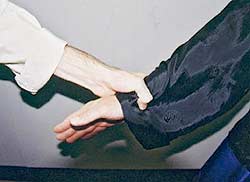
The attacker grabbing the right wrist.
|
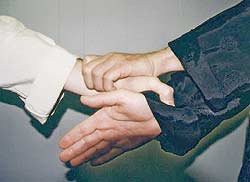
The defender grabs the attacker's hand.
|
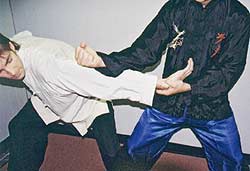
The defender strikes across
the triceps tendon of the attacker.
|
One of the fascinating parallels in martial arts development can be found
where almost the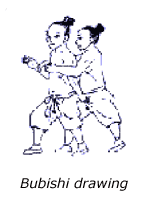 entire
48 self-defense techniques described in the Okinawan Bubushi (a once secret
text owned by many of Okinawa's early 20th century karate founders), reportedly
from Crane Fist and Monk fist systems, are basic techniques within the
Faan Tzi Ying Jow Pai system. entire
48 self-defense techniques described in the Okinawan Bubushi (a once secret
text owned by many of Okinawa's early 20th century karate founders), reportedly
from Crane Fist and Monk fist systems, are basic techniques within the
Faan Tzi Ying Jow Pai system.
While one would not surmise that Eagle Claw was a source for the training
behind the system described in the Okinawan Bubushi, the parallels are
uncanny. Such study offers a new way to understand the original Bubushi
art. Here Mr. Rothrock demonstrates several of the Eagle Claw answers
to those diagrams in the Bubishi.
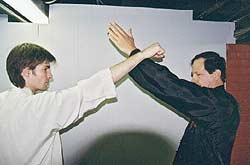
An attacker throws a right punch to Defender's
face. The defender parries with
left outer arm.
|
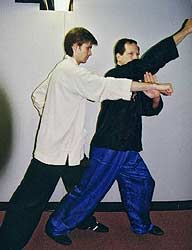
The defender turns 180 degrees to the left
and parries attacker's arm with left palm.
|
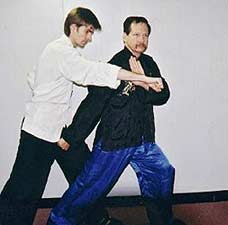
The defender strikes down into the groin with
the right arm.
|
Conclusion
I hope this brief article provides the reader with a glimpse into a truly
fascinating martial art, Faan Tzi Ying Jow Pai, Northern Eagle Claw.
Readers who practice other Chinese kung fu systems might recognize some
Chin Na (seizing and locking) components in their own art.
For karate students the connections is more obscure. Eagle Claw probably
did not directly influence the development of Okinawan Karate since it
remained in Northern China up until the 1920's, well after Karate's development.
But, Chinese kung fu systems did provide inspiration and influence upon
the development of karate on Okinawa. Thus undoubtedly some grasping,
seizing and joint manipulation knowledge bled over into early karate.
Early 20th century Okinawan masters, such as Gichen Funakoshi, spoke
of developing the hands and grip so as to be able to seize an opponent
tightly. In his early works he also demonstrated joint locks and take
downs. Others, such as Goju Ryu's founder Miyagi developed his hands to
the point that he could rip off chunks of bark from trees or be used to
penetrate soft areas of the body.
Within most karate systems today, however, this training is not longer
emphasized. Only within older karate kata are the ancient skills of grasping
and piercing techniques still retained.
Footnotes:
(1) Master Instructor isn't
simply a title; in the case of Faan Tzi Ying Jow Pai, it represents a
series of concrete acomplishments. It is awarded upon completion of a
very grueling examination requiring extensive knowledge of a most complex
system. Only a qualified instructor with decades of work on the system
would be able to pass the complexity of this examination. The requirements
for this examination are a complex story in their own right.
There are two main Eagle Claw lineage's in the USA at
this time. General Ngok Fei developed Ying Kuen (eagle fist or system)
and in1920 Ching Mo Gymnasium invited Chan Tzi Ching to teach the system
at their location. It was from here that the two lineages developed.
The first lineage:
Chan Tzi Ching -> Ng Wai Nung -> Shum Leung (NYC) -> Ernest Rothrock
In a separate lineage Giny and Lilly Lau are also teaching Eagle Claw
on the West Coast of the USA. Their lineage is:
Chan Tzi Ching -> Lau Kai Man -> Lau Fat Mang (their father) ->
Lili Lau
Both the Lau line and the Sheum Line go back to Chan Tzi Ching teaching
at the Ching Mo Gym in the 1920's
(2) Sections of the form work differing locks:
Rows 1 - 10 Locking the Elbow
Rows 11 - 20 Locking the Throat
Rows 21 - 30 Locking the Wrist
Rows 31 - 40 Locking the Foot
Rows 41 - 50 Locking the Waist
Rows 51 - 60 Locking the Finger
Rows 61 - 70 Locking the Head
Rows 71 - 80 Locking the Stance
Rows 81 - 90 Locking High Strikes
Rows 91 - 100 Locking Low Strikes
Rows 101 - 108 Special Death Locks of Eagle Claw
About The Author:
Victor Smith is a respected teacher of Isshinryu karate (6th degree black
belt) and tai chi chuan with over 26 years of training in Japanese, Korean
and Chinese martial arts. His training also includes aikido, kobudo, tae
kwon do, tang so do moo duk kwan, goju ryu, uechi ryu, sutrisno shotokan,
tjimande, goshin jutsu, shorin ryu honda katsu, sil lum (northern Shaolin),
tai tong long (northern mantis), pai lum (white dragon), and ying jow
pai (eagle claw). Over the last few years he has begun writing on, researching
and documenting his studies and experiences. He is the founder of the
martial arts website FunkyDragon.com/bushi
and is Associate Editor of FightingArts.com. Professionally he is a business
analyst, but also enjoys writing ficton for the Destroyer Universe.
|